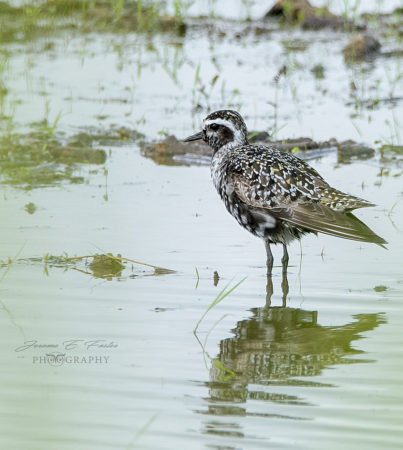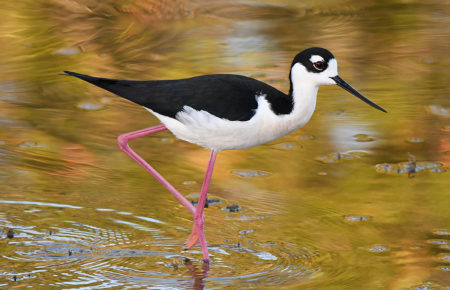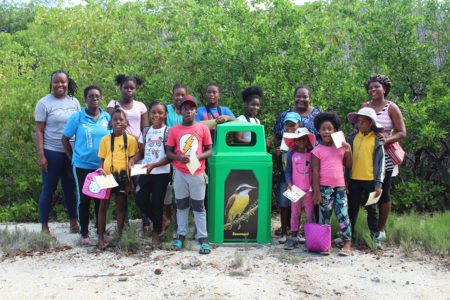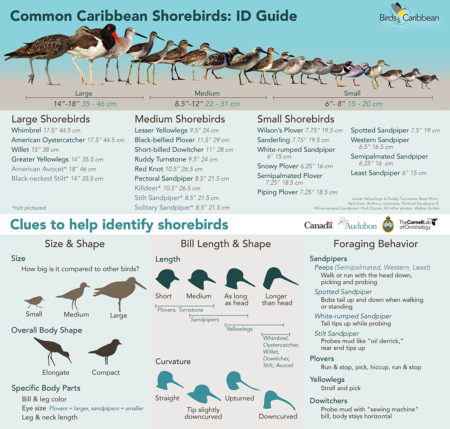Caribbean shorebirds count in 2020! With growing threats to their habitats, perhaps now more than ever.

Our Caribbean partners went out “shorebirding” in their favorite spots between September 3 and 9, 2020, as part of the Global Shorebird Count. Despite some local challenges, the efforts of Caribbean birders were rewarded. Worldwide, preliminary results show 1,567checklists from 1,303 unique locations where 146 species of shorebirds were recorded. The official 2020 results summary results have not been posted yet but will appear on the World Shorebirds Day website. The Caribbean should be well represented.
In the Dominican Republic, Grupo Acción Ecológica visited several sites important to shorebirds in Samaná, San Cristobál, La Vega and Peravia. They recorded a wide range of shorebird species and some large groups of birds including 800 Semipalmated Sandpipers, 600 Stilt Sandpipers, 420 Black-bellied Plover, and 350 Semipalmated Plover. They even encountered some less common species, like a group of three Wilson’s Phalaropes.
In Barbados, several BirdsCaribbean members spent the week of The Global Shorebird Count visiting the many swamps across the island. Notable observations included an impressive group of 32 Whimbrels, in addition to 6 Upland Sandpipers and another Wilson’s Phalarope. Other birds observed included Semipalmated Sandpiper, White-rumped Sandpiper, Lesser Yellowlegs, and Ruddy Turnstone, among many others.

In Guadeloupe, Anthony Levesque visited Pointe des Chateaux and counted 430 Semipalmated Sandpipers, 19 Hudsonian Godwits and even a European subspecies of Whimbrel. See all the species on his eBird checklist here. On a different day during the week, he was able to capture an Eastern and Western subspecies of Willet foraging next to each other (see the eBird checklist for a photo). According to eBird, the “Eastern” subspecies breeds in saltmarshes along East Coast of U.S. while the “Western” breeds in marshy grasslands in the Interior West of North America. It seems that “East meets West” in Guadeloupe’s wetlands during migration!
Emma Lewis provided an excellent round-up of World Shorebirds Day with stunning photos in a blog article for Global Voices:
For some Jamaican birders, the highlight of World Shorebirds Day was perhaps the appearance of an adorable family of West Indian Whistling Ducks, captured on video by Damion Whyte, biologist, birder and a passionate social media educator on all things environmental. Others in Jamaica were not so lucky. Members of BirdLife Jamaica — much fewer in numbers this year, due to COVID-19 restrictions — trekked in ones and twos to their favorite viewing sites. One member, on arriving in Old Harbour Bay after heavy rains the day before, found the location overwhelmed with mud!

There were also more sociable events on the calendar. The NGO SusGren (Sustainable Grenadines) shared photos of an educational trip to the newly-restored Ashton Lagoon on Union Island. In celebration of World Shorebirds Day 2020, SusGren in collaboration with Environmental Attackers conducted educational outreach for students of the Stephanie Brown Primary school. The high-spirited students, who were out of their beds as early as 5:30 a.m. for the session, were engaged in activities such as bird labeling, bingo, and bird identification.
Shorebirds rely on Caribbean habitats to rest and refuel during their long migratory journeys, while some are resident year-round in the region. Large tourism developments, including hotels, marinas and other projects, continue to be built along the islands’ coastlines, resulting in the destruction of vital mangroves and wetlands. Currently, three tourism projects under way in Grenada threaten wetlands that shelter birds and other endangered species, including turtles. On other islands, hunting and plastic pollution are major threats for shorebirds.
As Emma noted, “World Shorebirds Day in the Caribbean is not only a celebration of the birds themselves, but of the beautiful places they call home, even if only temporarily for many of them.” Thank you to everyone who participated in the event this year!
In case you missed it earlier, you can download the pdf of our Quick ID Guide to Common Shorebirds of the Caribbean here. For use in the field, print on card-stock and laminate.
















